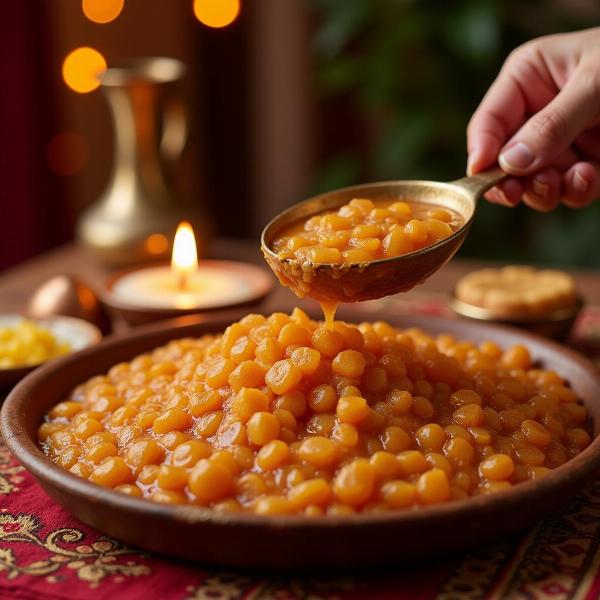Halwa, a word that evokes images of rich, decadent desserts, holds a special place in Indian cuisine and culture. But what exactly does “halwa meaning in hindi” entail? This article delves into the various meanings, types, and cultural significance of halwa in the Hindi language and Indian context. We’ll explore its diverse forms, from the simple sooji halwa to the more elaborate gajar ka halwa, and understand why this sweet treat is so beloved across the Indian subcontinent.
Understanding the Word “Halwa”
“Halwa” (हलवा) in Hindi is derived from the Arabic word “hulw,” meaning sweet. This reflects the fundamental characteristic of halwa: its sweetness. While primarily referring to a dense, pudding-like dessert, the word can also be used metaphorically to describe something easy or effortless. For instance, the phrase “halwa hai kya?” (Is it halwa?) is often used rhetorically to imply that a task is not as simple as it appears. This linguistic nuance adds another layer to the understanding of “halwa meaning in hindi”.
A Diverse Culinary Landscape: Types of Halwa
The beauty of halwa lies in its versatility. Numerous variations exist across India, each boasting unique ingredients, textures, and flavors. Some popular types include:
- Sooji Halwa (Suji ka Halwa): Made from semolina, this is perhaps the most common and easily prepared halwa.
- Gajar ka Halwa (Carrot Halwa): A rich and flavorful halwa made with grated carrots, milk, and sugar. This is a winter favorite in many Indian households.
- Moong Dal Halwa: A slightly more elaborate halwa made from split yellow lentils, ghee, and sugar.
- Aate ka Halwa (Wheat Flour Halwa): This halwa uses whole wheat flour and is often enjoyed during festivals.
- Badam Halwa (Almond Halwa): A luxurious halwa made from blanched almonds, milk, and sugar.
Halwa and its Cultural Significance
Halwa is not just a dessert; it’s an integral part of Indian culture and traditions. It’s often prepared for festivals, celebrations, and religious ceremonies. It’s a symbol of hospitality and is often offered to guests as a gesture of welcome. The sharing of halwa signifies togetherness and joy. This deep-rooted cultural significance further enriches the understanding of “halwa meaning in hindi”.
 Halwa in Indian Festivals
Halwa in Indian Festivals
Beyond the Sweetness: Metaphorical Usage
As mentioned earlier, “halwa” can also be used figuratively. The expression “halwa hai kya?” highlights the versatile nature of the word, demonstrating how it extends beyond its culinary context. This rhetorical question is used to emphasize the difficulty of a situation, challenging the assumption that something is easy. This adds a layer of cultural understanding to the meaning of “halwa” beyond its definition as a sweet.
Making Halwa at Home
Preparing halwa at home is a relatively simple process, especially for basic varieties like sooji halwa. Numerous online resources and cookbooks provide detailed instructions and variations to suit different preferences. This accessibility and ease of preparation contribute to halwa’s popularity as a beloved homemade treat.
Conclusion: More Than Just a Dessert
Understanding “halwa meaning in hindi” goes beyond a simple definition. It encompasses a world of flavors, traditions, and cultural nuances. From the simple sooji halwa to the elaborate badam halwa, this sweet treat occupies a significant place in Indian cuisine and culture. Its metaphorical use further adds to its richness and reflects its deep integration into everyday language.
FAQ
- What is the main ingredient in sooji halwa? Semolina (sooji) is the primary ingredient.
- When is gajar ka halwa typically eaten? Gajar ka halwa is a popular winter dessert.
- What does “halwa hai kya?” mean? It’s a rhetorical question implying a task is not as easy as it seems.
- Is halwa served during festivals? Yes, halwa is commonly prepared and served during various Indian festivals and celebrations.
- Where does the word “halwa” originate from? The word “halwa” is derived from the Arabic word “hulw”.
- What is the cultural significance of halwa in India? Halwa is a symbol of hospitality and is often shared during celebrations and festivals.
- Is it easy to make halwa at home? Yes, especially basic varieties like sooji halwa are relatively easy to make at home.
Meaning-Hindi.in offers professional translation services for businesses, legal documents, technical manuals, websites, educational materials, and more. We specialize in Hindi and other Indian languages, ensuring accurate and culturally sensitive translations. Need help with translating your documents related to food, culture, or any other subject? Contact us at [email protected] or call us at +91 11-4502-7584. Meaning-Hindi.in is your trusted partner for all your translation needs.